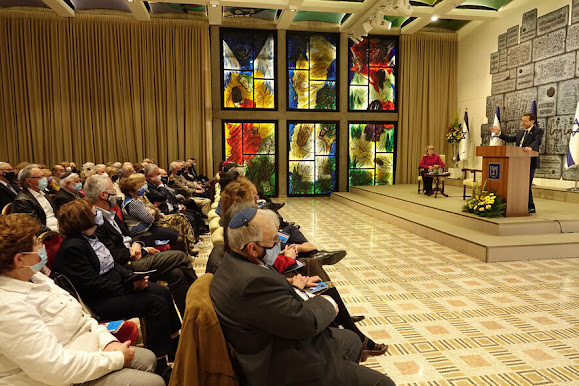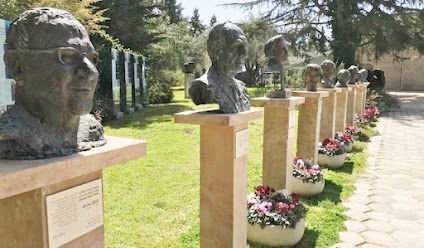By the end of March most of Israel had had
quite enough of one of the coldest and rainiest winters in decades. Heating
bills were soaring and Lake Kinneret was just a few centimeters shy of reaching
its upper limit. And then, literally out
of the blue, dawned the harbinger of the summer to come – a cloudless sky and
sunshine. It chanced to be the day set
aside months ago for a visit by members of the long-established IBCA (Israel,
Britain and the Commonwealth Association) to Beit Hanassi – the President’s
Residence in Jerusalem.
Conceived and organized by IBCA’s dynamic
chairperson, Brenda Katten, the visit was in no sense a political event – IBCA
is not a political organization. Its purpose, unchanged since its foundation
back in 1953, has been to encourage, develop and extend social, cultural and
economic relations between the peoples of Israel, Britain and the Commonwealth.
One of its earliest chairpersons was the President’s father, Chaim Herzog, who had
been a senior officer in the British army during the Second World War. His son,
Isaac, who has followed in his footsteps in the presidency, has maintained a
link with IBCA throughout his career.
So, despite the presence of members
of the Diplomatic Corps, including the British, Australian and Canadian
ambassadors to Israel, the occasion was essentially social. A few speeches there inevitably were, but the
highlights of the occasion were a group photograph of IBCA members with the
President, an informed explanation of the artwork that adorns the splendid
reception area of Beit Hanassi, and a guided tour of the gardens in which the
Presidential residence is sited – an experience enhanced by the unexpected sunshine.
The group photograph was in the capable hands of Charles Green, for twenty years official investiture photographer at Buckingham Palace, who made Aliyah a few years ago. The guests were grouped on the steps leading down into the gardens, President Herzog joined them in the center of the front row, and Green snapped merrily away.
The
reception hall is a repository of impressive art works. Perhaps the most striking is the painted
ceiling by artist Naftali Bezem – 63 squares of acrylic tracing the story of
his journey from persecution in Europe to freedom in Israel. One wall is enhanced by a 6-meter high stained
glass triptych by Reuven Rubin illustrating biblical themes. At the far end of the hall, facing visitors
as they enter, is the Jerusalem Wall of Fame, a loose representation of the
Western Wall.
The
current Beit Hanassi is the third Presidential Residence in Israel’s short
history. Chaim Weizmann, Israel’s first president, used his private home as the
first. During the term of Israel’s
second president, Yitzhak Ben Zvi, the Residence was located in Jerusalem’s
Rehavia neighborhood. The current building was conceived, designed and
constructed during the 10-year term of President Zalman Shazar, Israel’s third
president.
Once the idea of a
purpose-built official residence had been approved, Shazar asked that it be
built in a residential neighborhood of Jerusalem, in accordance with the
biblical verse “Among my own people I dwell”. Some ten dunams (approximately 2.5 acres) of
land was selected on a hill in the Talbiyeh district.
In 1964 the State of
Israel announced a competition, open to Israeli architects only, to design the
new President’s Residence. Anything
palatial or overblown was ruled out. The
guidelines specified that the building should be unassuming but designed to
enable all the functions of the President to be fulfilled. Forty-seven bids
were submitted to the committee, which was headed by Teddy Kollek who later
became Jerusalem’s longest-serving mayor. The committee chose the design by
Abba Elhanani, then one of Israel’s most prominent architects.
Divided into three wings
– ceremonial, offices and residential – the Residence is constructed of local
materials such as granite from Eilat and Jerusalem stone. The roof, which is
rectangular in shape, consists of flat white domes reminiscent of the domes in
the Old City of Jerusalem. It was completed in 1971. Splendid yet understated
as it is, there is a view that the ceremonial wing might need expanding to take
account of Israel’s growing status on the world stage, and the requirement to
host larger and more frequent official functions.
For example the guest
list for the state dinner on 22 January 2020, hosted by then-President Reuven
Rivlin to inaugurate the Fifth World Holocaust Forum, had to be severely
restricted for lack of room. No spouses were invited, while large marquees were
erected in the front of the building to serve as a reception venue and to accommodate
security personnel.and officials accompanying key dignitaries.
As for the IBCA visit, a high point for many of the guests was the guided tour of the gardens. The grounds are adorned at every turn with sculptures, busts, pieces of ancient architecture and works of art.
One striking feature is a row of the busts of Israel’s 10 past presidents to date. Behind each is a large placard bearing an account in Hebrew, English and Arabic, of the main achievements of their presidencies.
All around the garden are trees planted by distinguished guests to the Residence. A Pope, US Presidents, British royalty – each has left in the grounds of Beit Hanassi a lasting memorial of the fact that they have visited Israel and been hosted by its President. The IBCA members who participated in their own private visit, will have their group photograph as a lasting record of a special and privileged occasion.“You are invited to the
home of the Israeli President for an unforgettable educational experience,”
runs the opening sentence of a new website run by Makom, a branch of the Jewish
Agency. Very recently Makom has started
offering English-language tours of the President’s Residence online via Zoom.
Makom was established in 2006 as a partnership between the Jewish Agency for Israel and twelve Jewish Community Federations in North America. The organization now also works across the world including in the UK, South Africa, France and Israel, designing and running educational programs aimed at optimizing the possibilities that modern Jewish life affords.
Their initiative is linked
to “Israeli Hope” workshops, a project of former President of Israel, Reuven
Rivlin. In their behind-the-scenes tour at the heart of Beit Hanassi, participants
hear about the history and role of the Israeli presidency, learn of the impact
and influence of former presidents, and explore the relationships between the
presidents, Israeli society, and the Jewish world.
No-one who undertakes a
tour of the splendid Beit Hanassi can fail to be impressed by the beauty,
artistry and living history embodied in the residence and equally in its garden
and grounds. It has been described as “Israel’s
symbolic home” – a view that many visitors, distinguished and otherwise, will surely
carry away with them.
Published in the Jerusalem Report and Jerusalem Post on-line, 14 April 2022https://www.jpost.com/jerusalem-report/article-704164



No comments:
Post a Comment